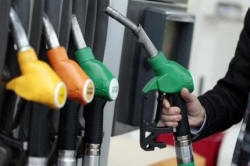|
 Oil
falls after Goldman cuts forecasts Oil
falls after Goldman cuts forecasts
 Send a link to a friend
Send a link to a friend
[September 11, 2015]
By Lisa Barrington
LONDON (Reuters) - Oil prices fell on
Friday after Goldman Sachs cut its crude forecasts, citing global
over-supply and concerns over the health of the Chinese economy, and
after Saudi Arabia dismissed the idea of an oil producer summit.
|
|
 Joining a long list of banks cutting their price forecasts, Goldman
Sachs on Friday reduced its 2015 U.S. crude oil forecast to $48.10 a
barrel, down from $52. The bank lowered its 2016 forecast for U.S.
crude to $45 from $57. Joining a long list of banks cutting their price forecasts, Goldman
Sachs on Friday reduced its 2015 U.S. crude oil forecast to $48.10 a
barrel, down from $52. The bank lowered its 2016 forecast for U.S.
crude to $45 from $57.
Goldman cut its 2015 Brent price forecast to $53.70 a barrel from
$58.20, and said it saw 2016 Brent prices at $49.50, down from its
earlier $62 forecast.
Brent for October was down $1.00 at $47.89 a barrel by 0830 GMT.
U.S. crude, also known as West Texas Intermediate or WTI, was down
$1.05 at $44.87 a barrel.
Investors largely ignored a relatively bullish report from the
International Energy Agency (IEA).
The agency said a move by the world's big oil exporters in OPEC, led
by Saudi Arabia, to defend their market share by not reducing
production appeared to be working.

"Oil's price collapse is closing down high-cost production from
Eagle Ford in Texas to Russia and the North Sea," the IEA said in
its monthly report.
The IEA said the closure of some non-OPEC oil production "may result
in the loss next year of half a million barrels a day – the biggest
decline in 24 years".
Core members of the Organization of the Petroleum Exporting
Countries see no reason to cut production, despite the fall in oil
prices.
Saudi Arabia thinks a summit of oil-producing countries would fail
to produce concrete action toward defending prices, sources familiar
with the matter said on Thursday.
[to top of second column] |

The comments followed a meeting of Gulf Arab oil ministers with
Qatar's emir in Doha, at which Venezuela's proposal for an OPEC and
non-OPEC summit was discussed.
Oil prices rallied on Thursday after U.S. Energy Information
Administration (EIA) data showed demand for gasoline over the latest
four-week period rose almost 4 percent from a year ago.
Crude inventories rose 2.6 million barrels to 458 million barrels in
the past week, compared with analysts' expectations for an increase
of 933,000 barrels.
(Additional reporting by Meeyoung Cho in Seoul; Editing by Dale
Hudson and Christopher Johnson)
[© 2015 Thomson Reuters. All rights
reserved.] Copyright 2015 Reuters. All rights reserved. This material may not be published,
broadcast, rewritten or redistributed.

 |